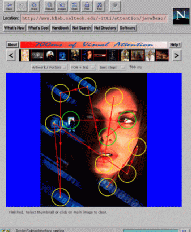-
The Traffic Signs database was kindly provided to us by Werner Ritter
at Daimler-Benz. Each 512x384 image is evaluated by the model in
approximately 10-15 seconds on a PC computer.
- The Military Vehicle database is the "Search 2"
image database which Dr. Lex Toet at TNO-Human Factors Research
Institute, The Netherlands was kind enough to send us; this database
of high-resolution images (6144x4096 pixels) has been designed to test
human as well as model target detection performance with complex
natural scenes. Each 70Mb-image takes 15 minutes and 484Mb of RAM to
evaluate on a 500MHz DEC/Alpha workstation.
- The Pedestrians database was kindly made
available to us by Constantine Papageorgiou, who works with Tommy Poggio
at MIT/CBCL as part of the MIT/Harvard/Caltech MURI project; with this
database, we are investigating whether a rapid selection of a few interesting
image locations might speed-up Constantine's pedestrian detector algorithm.
- The Pedestrians - Trained database was evaluated using a
specialized version of our model, in which supervised learning allowed
us to tune the weights of the different feature maps in the model. The
first, third, fifth, etc. images were used as training set, and the
remaining images as test set.
- The Good Housekeeping database was submitted to us by
Peter Walker, Director of the Neural Nets Group at McCann-Erickson,
McCann-Erickson House, 36 Howland Street LONDON W1A 1AT (McCann is one
of the world's largest advertising agencies, part of IPG. HQ in NY).
- The other image databases were either collected from the web or shot
using a consumer-electronics video camera.
|  |


